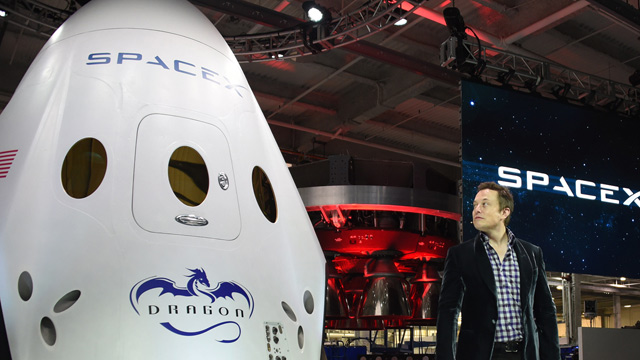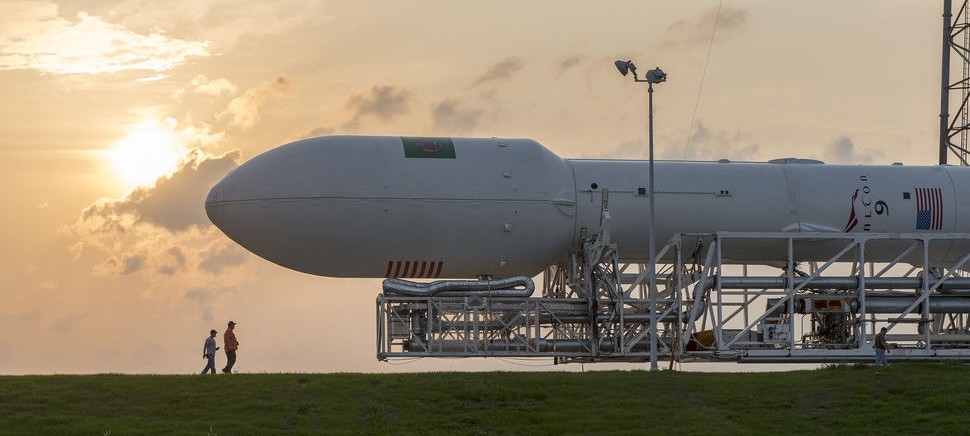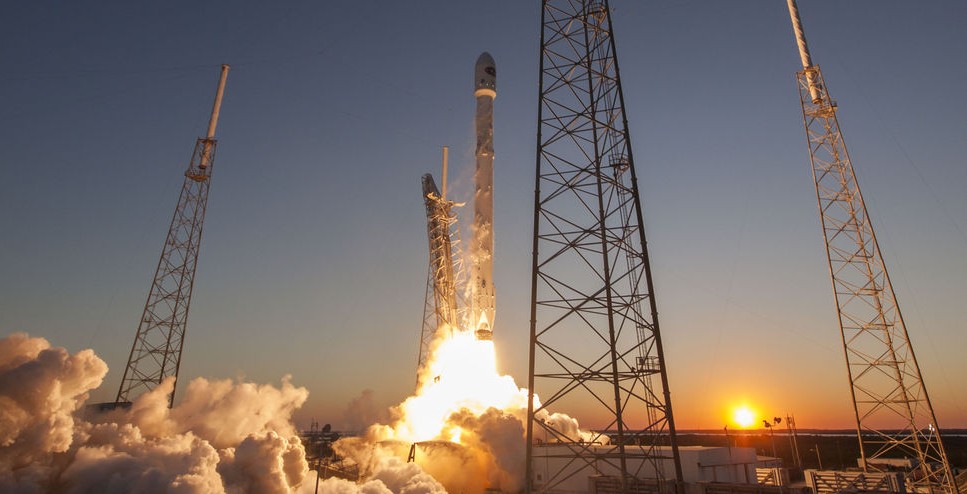

News
Of Mice And Musk: A SpaceX Odyssey
Elon Musk has dreamed of a human colony on Mars since he was a young man. Today, his SpaceX company is taking the first steps toward achieving that dream.
As Ashlee Vance tells it, one wall of Elon Musk’s office at SpaceX headquarters in Hawthorne, California, contains two posters of Mars. On the left is Mars as it exists today – a frozen, lifeless orb. On the right is Musk’s vision of Mars as it could be — a happy place inhabited by humans who frolic on verdant continents surrounded by oceans.
“I would like to die thinking that humanity has a bright future,” he tells Vance while eating cookies and cream with sprinkles on top. “If we can solve sustainable energy and be well on our way to becoming a multi-planetary species with a self-sustaining civilization on another planet—to cope with a worst-case scenario happening and extinguishing human consciousness— then I think that would be really good.” No one has ever accused Elon Musk of thinking too small.
At the turn of the 21st century, Musk had two Martian fantasies. One was to send a colony of mice to the Red Planet and bring them back again, along with their interplanetary babies. The other involved building a greenhouse on Mars and letting Earthlings see the plants inside grow over the internet. Each venture required at least one if not two rocket ships.
He and a coterie of friends traveled twice to Moscow, once in 2001 and again in 2002, trying to purchase surplus Russian rockets that could be refurbished for the Martian missions. The first time did not go well. Recalls Jim Cantrell, one of the team that traveled to Moscow with Musk, “One of their chief designers spit on me and Elon because he thought we were full of shit.” On the second excursion, Musk became convinced the Russians he was meeting with were only interested in fleecing a gullible American with too much money and too few brains.
On the way home from the second failed mission, Musk astonished his team by announcing, “Hey, guys, I think we can build this rocket ourselves.” In June 2002, Space Exploration Technologies, popularly known as SpaceX, was formed to build a cheaper rocket that could carry small payloads into space for paying clients on an average of once a month. The only problem? It had no rocket.
Such trifles were never matters to hold Elon Musk back. He assembled a team of committed rocket engineers and set about accomplishing, with millions, what NASA spent billions doing. Musk’s principle talent, apart from concocting outrageously impossible dreams, is finding people to work for him who are ready, willing and eager to give up all semblance of a normal life in exchange for insane working hours in remote locations. One test launching area was set up in the middle of Texas and another on far away Kwajalein Island, the largest island in an atoll between Guam and Hawaii that is part of the Marshall Islands.
“I would like to die thinking that humanity has a bright future”
SpaceX CEO, Elon Musk
Musk is not a man without a sense of humor. He dubbed his new rocket Falcon 1, paying homage to the Millennium Falcon of Star Wars fame. On its first flight on March 24, 2006, it crashed back to Earth after only 25 seconds. SpaceX employees dutifully donned scuba gear to retrieve some of the pieces from the ocean and set about rebuilding for another attempt.
Musk responded by hiring more engineers and starting work on a brand new rocket, the Falcon 9, that featured one large central rocket surrounded by 8 smaller rockets. Despite the failure of Falcon 1, Musk was already busy positioning the company to bid on NASA contracts to resupply the International Space Station.
On September 1, 2008, Falcon 1 flew its first successful mission. SpaceX was a viable commercial company at last but one that was rapidly going broke. At the end of 2008, Musk knew he would have to choose between SpaceX and Tesla. Alone, one of them might survive. Together? The odds were, both would fail. Musk worried that Tesla would be bought out by one of the Big Three automakers and become just a small part of a giant company.
Later in 2008, Tesla was within hours of defaulting on its payroll obligations. If that happened, Musk’s personal fortune would be gone, along with Tesla and SpaceX. He asked for help from venture capital group VantagePoint but was rebuffed. That’s when Musk put all his chips on red and let them ride.
With all of his dreams and aspirations on the line, Musk executed a colossal bluff. He told investors he would put in $40,000,000 of his own fortune to keep the business going — $40,000,000 he didn’t have. Based on his assurances, other investors agreed to put up $20,000,000 more in financing and the crisis passed. A few weeks later, NASA awarded SpaceX a $1.6 billion contract to do twleve ISS re-supply missions.
Antonio Gracias, a Tesla and SpaceX investor and one of Musk’s closest friends, watched all of this at close hand. He says 2008 told him everything he would ever need to know about Musk’s character. “He has the ability to work harder and endure more stress than anyone I’ve ever met,” Gracias says. “What he went through in 2008 would have broken anyone else. Most people who are under that sort of pressure fray. Their decisions go bad. Elon gets hyperrational. He’s still able to make very clear, long-term decisions. The harder it gets, the better he gets.”
Today, SpaceX launches an average of one rocket a month, carrying payloads for many companies and several nations. Its prices undercut those of Boeing, Lockheed Martin, and Orbital Science by a wide margin. Many of its competitors rely on Russian and other foreign suppliers but SpaceX makes its machines from scratch in the U.S.
Its clientele includes Canadian, European, and Asian customers and it has more than 50 flights planned over the coming years worth more than $5 billion. The company remains privately owned, with Musk as the largest shareholder. SpaceX is profitable and is estimated to be worth $12 billion.
The Falcon 9 has gone from a fantasy to SpaceX’s workhorse. Painted pure white with only an American flag and the SpaceX logo adorning its sides, there’s nothing particularly flashy looking about the Falcon 9. It’s just an elegant, purposeful machine. And to think that for a period of weeks just a few years ago, it’s ability to lead mankind into the dawn of commercial space travel almost died before it was ever born, thanks to a bluff so bold and so daring, it would leave most of us breathless.
Jimmy Buffett once sang, “Read dozens of books about heroes and crooks, and I learned much from both of their styles.” Which one is Elon Musk? Read Ashlee Vance’s book and make up your own mind.
Source: Bloomberg
Elon Musk
Tesla investors will be shocked by Jim Cramer’s latest assessment
Jim Cramer is now speaking positively about Tesla, especially in terms of its Robotaxi performance and its perception as a company.

Tesla investors will be shocked by analyst Jim Cramer’s latest assessment of the company.
When it comes to Tesla analysts, many of them are consistent. The bulls usually stay the bulls, and the bears usually stay the bears. The notable analysts on each side are Dan Ives and Adam Jonas for the bulls, and Gordon Johnson for the bears.
Jim Cramer is one analyst who does not necessarily fit this mold. Cramer, who hosts CNBC’s Mad Money, has switched his opinion on Tesla stock (NASDAQ: TSLA) many times.
He has been bullish, like he was when he said the stock was a “sleeping giant” two years ago, and he has been bearish, like he was when he said there was “nothing magnificent” about the company just a few months ago.
Now, he is back to being a bull.
Cramer’s comments were related to two key points: how NVIDIA CEO Jensen Huang describes Tesla after working closely with the Company through their transactions, and how it is not a car company, as well as the recent launch of the Robotaxi fleet.
Jensen Huang’s Tesla Narrative
Cramer says that the narrative on quarterly and annual deliveries is overblown, and those who continue to worry about Tesla’s performance on that metric are misled.
“It’s not a car company,” he said.
He went on to say that people like Huang speak highly of Tesla, and that should be enough to deter any true skepticism:
“I believe what Musk says cause Musk is working with Jensen and Jensen’s telling me what’s happening on the other side is pretty amazing.”
Tesla self-driving development gets huge compliment from NVIDIA CEO
Robotaxi Launch
Many media outlets are being extremely negative regarding the early rollout of Tesla’s Robotaxi platform in Austin, Texas.
There have been a handful of small issues, but nothing significant. Cramer says that humans make mistakes in vehicles too, yet, when Tesla’s test phase of the Robotaxi does it, it’s front page news and needs to be magnified.
He said:
“Look, I mean, drivers make mistakes all the time. Why should we hold Tesla to a standard where there can be no mistakes?”
It’s refreshing to hear Cramer speak logically about the Robotaxi fleet, as Tesla has taken every measure to ensure there are no mishaps. There are safety monitors in the passenger seat, and the area of travel is limited, confined to a small number of people.
Tesla is still improving and hopes to remove teleoperators and safety monitors slowly, as CEO Elon Musk said more freedom could be granted within one or two months.
News
Tesla launches ultra-fast V4 Superchargers in China for the first time
Tesla has V4 Superchargers rolling out in China for the first time.

Tesla already has nearly 12,000 Supercharger piles across mainland China. However, the company just initiated the rollout of the ultra-fast V4 Superchargers in China for the first time, bringing its quick-charging piles to the country for the first time since their launch last year.
The first batch of V4 Superchargers is now officially up and running in China, the company announced in a post on Chinese social media outlet Weibo today.
The company said in the post:
“The first batch of Tesla V4 Superchargers are online. Covering more service areas, high-speed charging is more convenient, and six-layer powerful protection such as rain and waterproof makes charging very safe. Simultaneously open to non-Tesla vehicles, and other brands of vehicles can also be charged. There are more than 70,000 Tesla Superchargers worldwide. The charging network layout covers 100% of the provincial capitals and municipalities in mainland China. More V4 Superchargers will be put into use across the country. Optimize the charging experience and improve energy replenishment efficiency. Tesla will accompany you to the mountains, rivers, lakes, and seas with pure electricity!”
The first V4 Superchargers Tesla installed in China are available in four cities across the country: Shanghai, Zhejiang, Gansu, and Chongqing.

Credit: Tesla China
Tesla has over 70,000 Superchargers worldwide. It is the most expansive and robust EV charging network in the world. It’s the main reason why so many companies have chosen to adopt Tesla’s charging connector in North America and Europe.
In China, some EVs can use Tesla Superchargers as well.
The V4 Supercharger is capable of charging vehicles at speeds of up to 325kW for vehicles in North America. This equates to over 1,000 miles per hour of charging.
Elon Musk
Elon Musk hints at when Tesla could reduce Safety Monitors from Robotaxi
Tesla could be reducing Safety Monitors from Robotaxi within ‘a month or two,’ CEO Elon Musk says.

Elon Musk hinted at when Tesla could begin reducing Safety Monitors from its Robotaxis. Safety Monitors are Tesla employees who sit in the front passenger seat during the driverless rides, and are there to ensure safety for occupants during the earliest rides.
Tesla launched its Robotaxi fleet in Austin last Sunday, and after eight days, videos and reviews from those who have ridden in the driverless vehicles have shown that the suite is safe, accurate, and well coordinated. However, there have been a few hiccups, but nothing that has put anyone’s safety in danger.
A vast majority — close to all of the rides — at least according to those who have ridden in the Robotaxi, have been performed without any real need for human intervention. We reported on what was the first intervention last week, as a Safety Monitor had to step in and stop the vehicle in a strange interaction with a UPS truck.
Watch the first true Tesla Robotaxi intervention by safety monitor
The Tesla and UPS delivery truck were going for the same street parking space, and the Tesla began to turn into it. The UPS driver parallel parked into the spot, which was much smaller than his truck. It seemed to be more of an instance of human error instead of the Robotaxi making the wrong move. This is something that the driverless cars will have to deal with because humans are aggressive and sometimes make moves they should not.
The Safety Monitors have not been too active in the vehicles. After all, we’ve only seen that single instance of an intervention. There was also an issue with the sun, when the Tesla braked abnormally due to the glare, but this was an instance where the car handled the scenario and proceeded normally.
With the Robotaxi fleet operating impressively, some are wondering when Tesla will begin scaling back both the Safety Monitors and Teleoperators that it is using to ensure safety with these early rides.
CEO Elon Musk answered the inquiry by stating, “As soon as we feel it is safe to do so. Probably within a month or two.”
As soon as we feel it is safe to do so.
Probably within a month or two. We continue to improve the Tesla AI with each mile driven.
— Elon Musk (@elonmusk) June 30, 2025
Musk’s response seems to confirm that there will be fewer Teleoperators and Safety Monitors in the coming months, but there will still be some within the fleet to ensure safety. Eventually, that number will get to zero.
Reaching a point where Tesla’s Robotaxi is driverless will be another significant milestone for the company and its path to fully autonomous ride-sharing.
Eventually, Tesla will roll out these capabilities to consumer-owned vehicles, offering them a path to generate revenue as their car operates autonomously and completes rides.
For now, Tesla is focusing on perfecting the area of Austin where it is currently offering driverless rides for just $4.20 to a small group of people.
-

 News5 days ago
News5 days agoTesla Robotaxi’s biggest challenge seems to be this one thing
-

 News2 weeks ago
News2 weeks agoTesla confirms massive hardware change for autonomy improvement
-

 Elon Musk2 weeks ago
Elon Musk2 weeks agoElon Musk slams Bloomberg’s shocking xAI cash burn claims
-

 News2 weeks ago
News2 weeks agoTesla features used to flunk 16-year-old’s driver license test
-

 News2 weeks ago
News2 weeks agoTesla China roars back with highest vehicle registrations this Q2 so far
-

 News2 weeks ago
News2 weeks agoTesla dominates Cars.com’s Made in America Index with clean sweep
-

 News2 weeks ago
News2 weeks agoTexas lawmakers urge Tesla to delay Austin robotaxi launch to September
-

 News2 weeks ago
News2 weeks agoTesla’s Grok integration will be more realistic with this cool feature





















